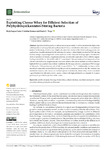Exploiting Cheese Whey for Efficient Selection of Polyhydroxyalkanoates-Storing Bacteria

Use este enlace para citar
http://hdl.handle.net/2183/38487
A non ser que se indique outra cousa, a licenza do ítem descríbese como Creative Commons CC-BY Attribution 4.0 International
Coleccións
- Investigación (FCIE) [1243]
Metadatos
Mostrar o rexistro completo do ítemTítulo
Exploiting Cheese Whey for Efficient Selection of Polyhydroxyalkanoates-Storing BacteriaData
2023Cita bibliográfica
Lagoa-Costa, B.; Kennes, C.; Veiga, M.C. Exploiting Cheese Whey for Efficient Selection of Polyhydroxyalkanoates-Storing Bacteria. Fermentation 2023, 9, 574. https://doi.org/10.3390/fermentation9060574
Resumo
[Abstract] Agroindustrial by-products hold an enormous potential to be bioconverted into high-value-added products such as polyhydroxyalkanoates (PHA), a cost-effective alternative to conventional plastics. In this study, cheese whey, a highly abundant side stream of the cheese making process, was explored as a feasible substrate for the selection of a mixed culture highly enriched in PHA-storing bacteria using a sequencing batch reactor under an aerobic dynamic feeding regime. For that, the absence/presence of thiourea, magnesium and iron, as well as the application of two different organic loading rates (OLR), i.e., 60 and 80 CmM d−1, were tested. The results showed an improved culture selection when thiourea, magnesium and iron were added to the culture medium as well as when the highest OLR was applied. Under these conditions, the biomass achieved a maximum PHA storage of 54% and a PHA production rate of 4.81 Cmmol-PHA L−1 h−1. Additionally, the study of the microbial community showed that during this period of maximum productivity, the biomass was enriched in Azoarcus and Amaricoccus bacterial species. Conclusively, cheese whey can be considered a good feedstock to efficiently select a mixed culture with high potential to accumulate PHA and a good way to give this by-product added value.
Palabras chave
Aerobic dynamic feeding
Cheese whey
Culture selection
Microbial community
Mixed microbial cultures
Polyhydroxyalkanoates
Cheese whey
Culture selection
Microbial community
Mixed microbial cultures
Polyhydroxyalkanoates
Versión do editor
Dereitos
Creative Commons CC-BY Attribution 4.0 International






